Fermenting peppers and tomatoes together is a great way to preserve their fresh flavors while adding a probiotic boost to your diet. One common question is whether you need to ferment them separately. The answer is no—combining them in the same jar works well too. Just make sure to cut the peppers into slices or halves to ensure even fermentation. The result is a tangy, slightly spicy mix that can be enjoyed on its own, added to sandwiches, or used as a topping for tacos.

Fermented Peppers and Tomatoes: Why You Should Try This Combo
Combining peppers and tomatoes in fermentation not only enhances their flavors but also boosts their nutritional content. Whether hot or mild peppers when combined with tomatoes creates a unique blend of flavors and textures. The tanginess of fermented tomatoes pairs perfectly with the natural sweetness and spice of peppers, resulting in a delicious condiment or side dish.
The Benefits of Fermented Peppers and Tomatoes
- Fermenting peppers and tomatoes together creates a nutrient-dense, probiotic-rich food.
- The combination is versatile and flavorful, suitable for various dishes.
- You can use different types of peppers—sweet, hot, or a mix—to customize the spice level.
- Fermentation enhances probiotics, aiding digestion and boosting gut health. It preserves essential vitamins and antioxidants, including:
- Vitamin C: Supports immune health and skin health.
- Vitamin A: Important for vision and immune function.
- Vitamin E: Protects cells from oxidative damage.
- Lycopene (from tomatoes): May reduce the risk of certain cancers and heart disease.
- Beta-carotene (from peppers): Supports skin health and may reduce inflammation.
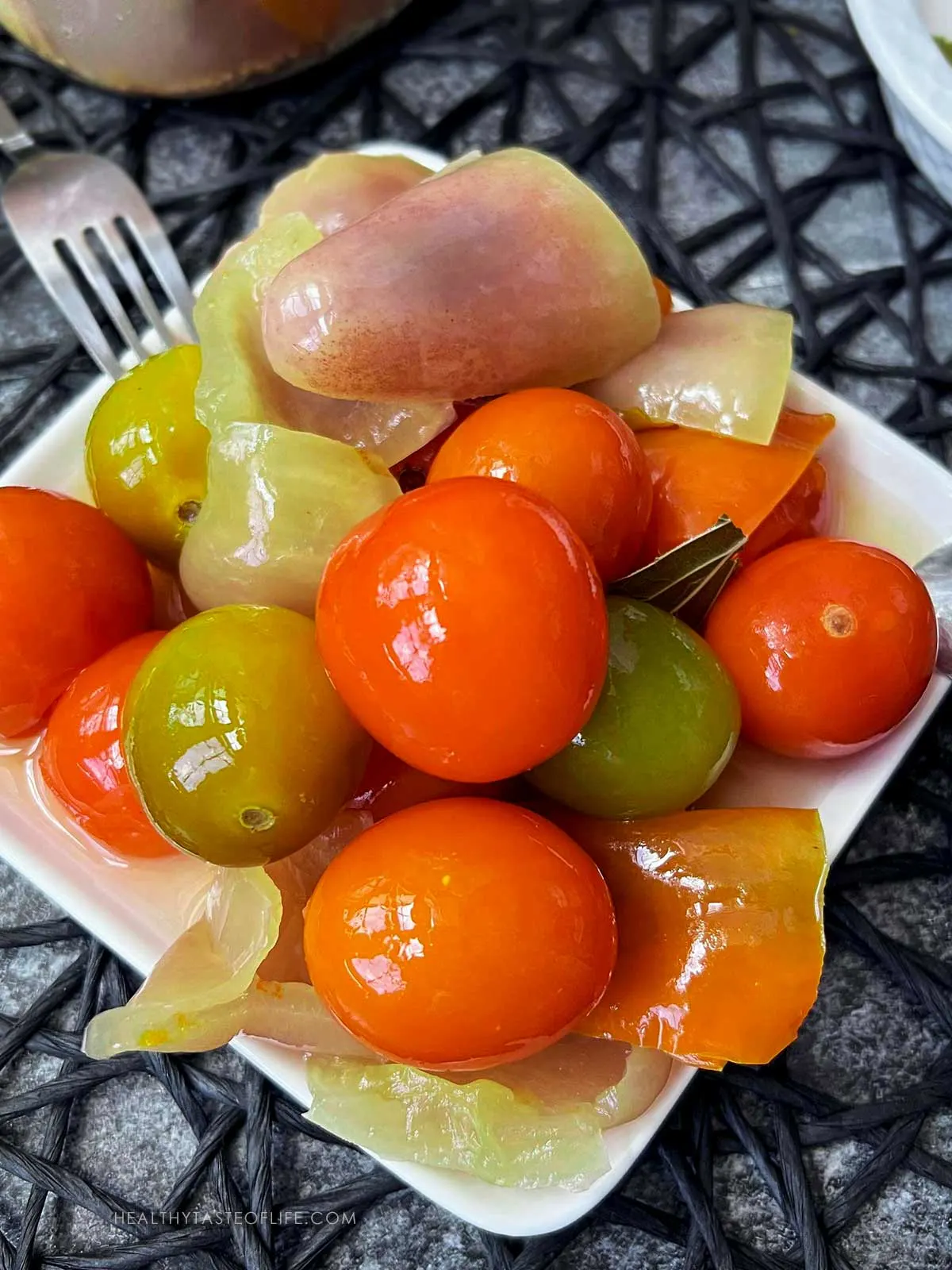
Fermenting Bell Peppers
When fermenting regular bell peppers (green, yellow, or red), the result is typically a tangy, slightly sour, and mildly sweet pepper with a firm yet slightly softened texture. The fermentation process enhances the natural sweetness of the peppers, especially for the red and yellow varieties, while the green peppers maintain a more tangy and slightly bitter flavor.
The Brine
For fermenting peppers and tomatoes, a 2-3% brine is commonly recommended.
The peppers retain much of their crunch, making them perfect for adding to salads, sandwiches, or as a tangy, probiotic-rich snack. The color also deepens slightly, creating vibrant, flavorful preserved peppers that can be used in various dishes.
To calculate this for 1000 ml of water:
- 2% brine: 20 grams of salt
- 3% brine: 30 grams of salt
This range provides a good balance, ensuring the vegetables ferment properly without becoming too salty. Most people find that a 3% brine works well for a variety of vegetables, including peppers and tomatoes.
How To Ferment Peppers and Tomatoes Together
- Wash the tomatoes and peppers thoroughly. Tip if you have larger tomatoes: pierce with a skewer or toothpick to help the brine penetrate easier.

- Place the tomatoes and halved or quartered peppers in a sterilized jar, layering with spices or herbs if desired.
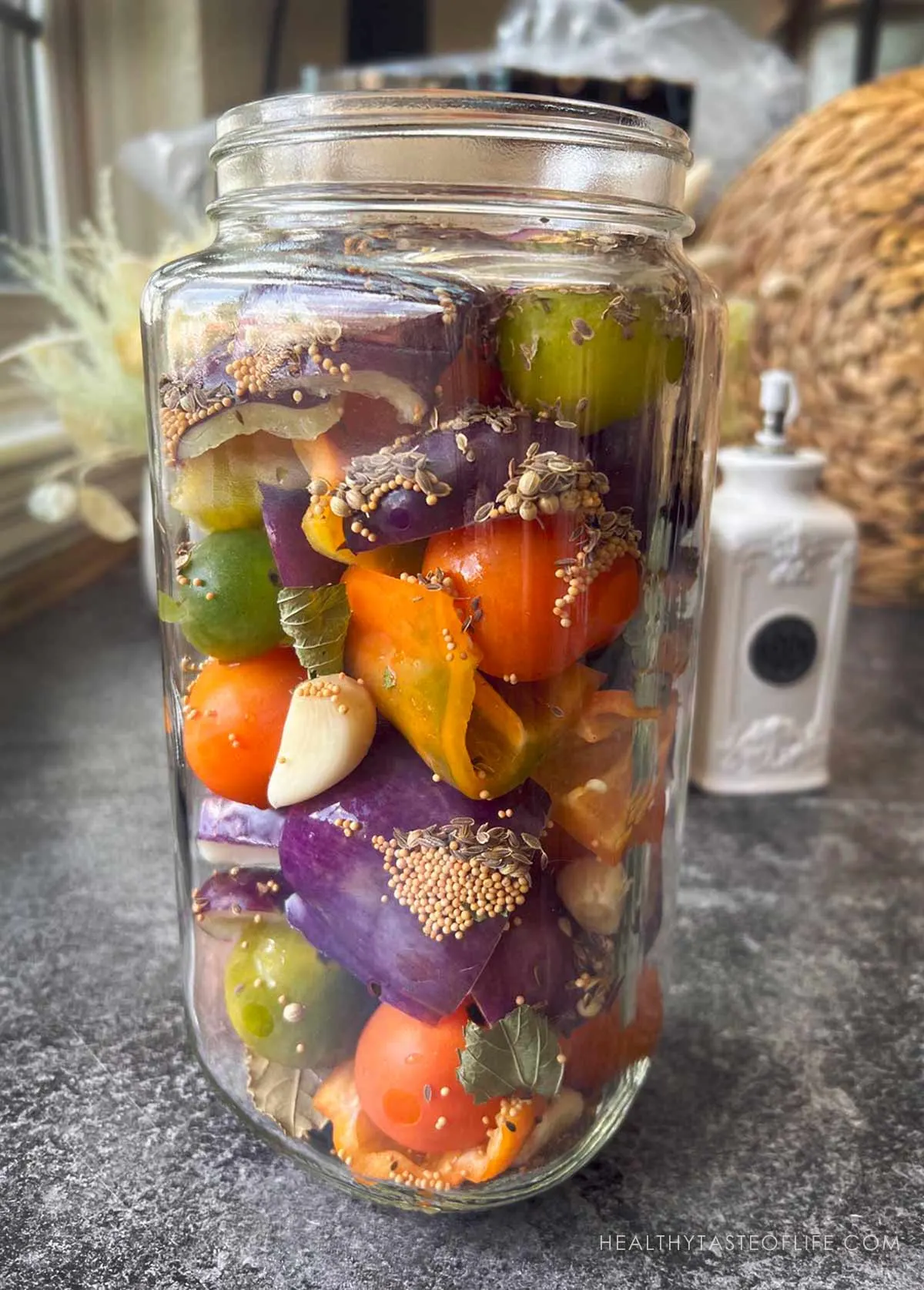
- Mix 1.8 tablespoons of sea salt with 1000 ml of water to create a 3% brine solution.
- Pour the brine over the vegetables, ensuring everything is fully submerged. Use a fermentation weight to keep everything under the brine, and cover the jar with a fermentation lid or cheesecloth.
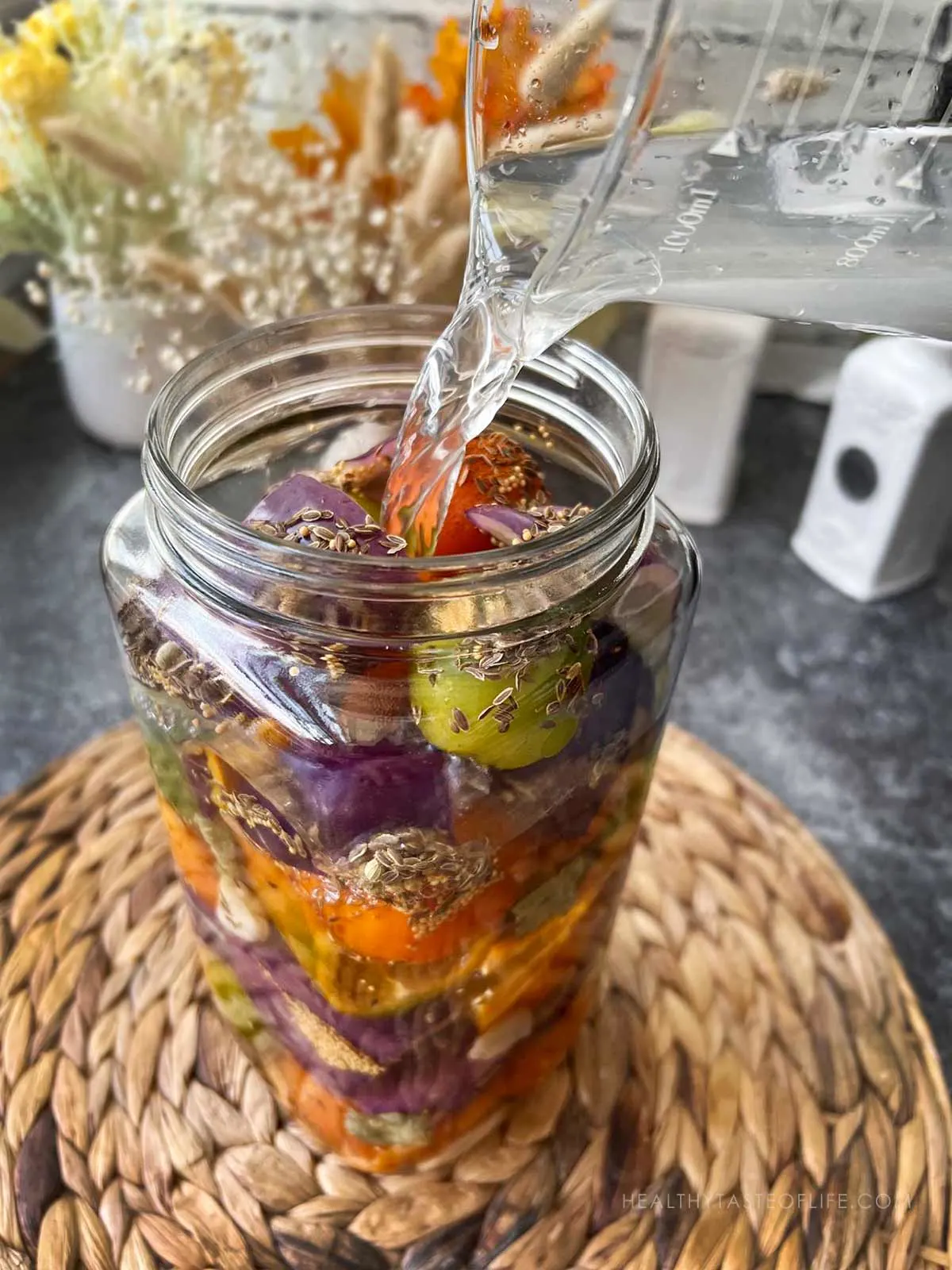
- Do not seal, as air is needed for fermentation.
- Ferment in a cool, dark place for 3-5 days, depending on the temperature.
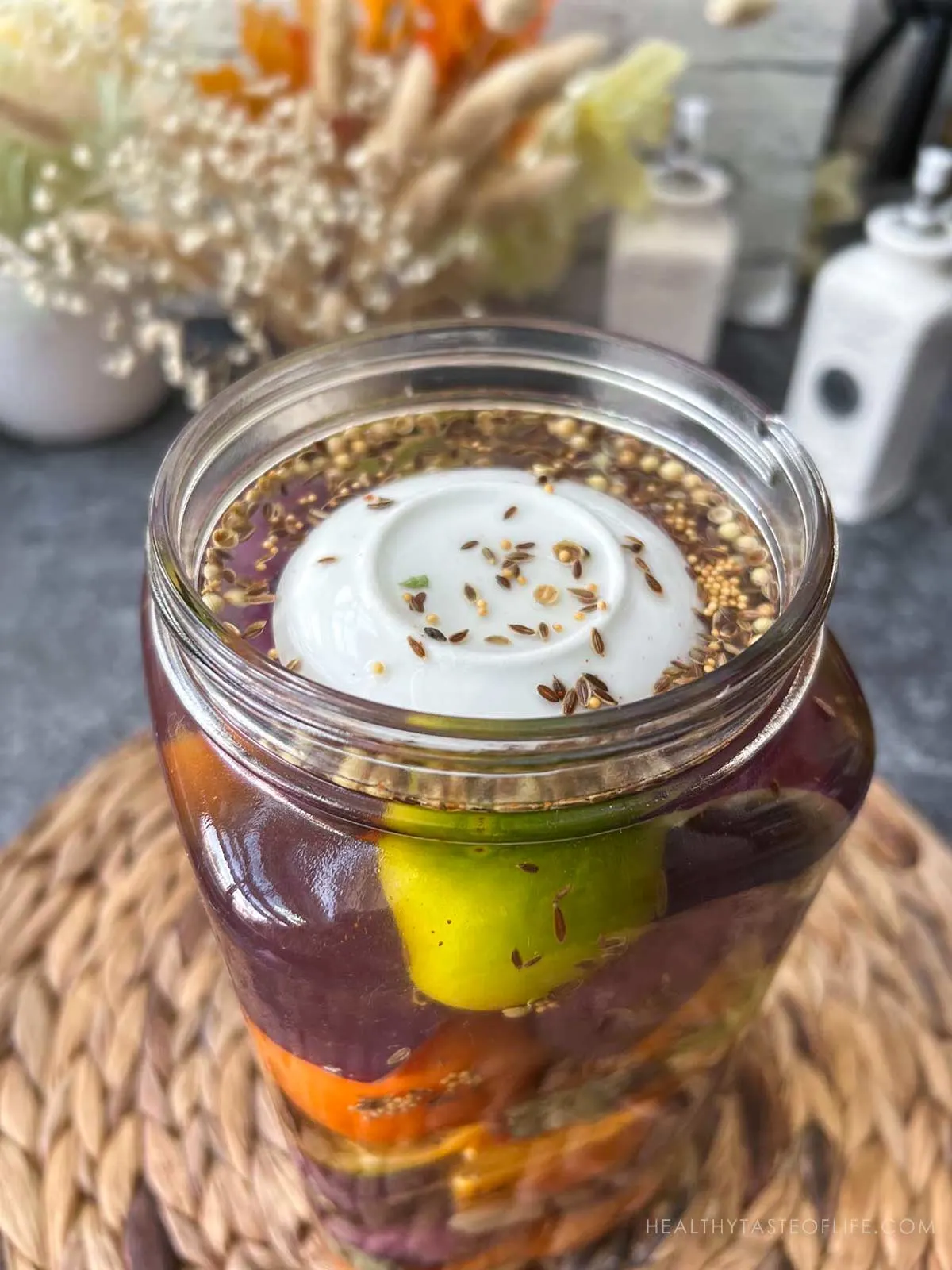
- Check daily to ensure the vegetables stay submerged and to release gas buildup.
- Shake the jar gently if needed. Once the desired fermentation is reached, transfer to the refrigerator to slow down the fermentation the process.

Tips for Perfect Results Every Time
- Use the Right Brine Ratio: A 2-3% salt brine is optimal for fermentating peppers and tomatoes.
- Maintain Consistent Temperature: Ferment in a cool, dark place at around 65-75°F (18-24°C) for optimal results.
- Use Good Quality Non-Iodized Salt: Opt for sea salt or kosher salt to avoid additives (anti-caking agents) that can interfere with fermentation.
- Cut or Score Vegetables: This helps the brine penetrate evenly, ensuring consistent fermentation when you have large vegetables.
- Adjust Fermentation Time for Size: Larger pieces of peppers and tomatoes may require a longer fermentation time.
- Keep Vegetables Submerged: Use a weight to keep the peppers and tomatoes fully submerged in the brine to prevent mold.
- Store Away from Sunlight: Ferment in a dark place to avoid light exposure, which can degrade the color and nutrients.
- Blanch Peppers Before Fermenting: For softer peppers, quickly blanch them in boiling water before fermenting.
- Monitor Fermentation Time: Ferment for 5-7 days at room temperature, but taste regularly to achieve your desired flavor., then transfer to refrigerator to slow down the fermentation process.
- Use Fresh, Organic Produce: Start with fresh, organic peppers and tomatoes for the best flavor and nutrient retention.
- Experiment with Different Peppers: Mix regular bell peppers with hot varieties like jalapeños or habaneros for diverse flavors.
- Combine with Other Vegetables: Add onions, carrots, cucumbers or cauliflower to the ferment for added flavor and variety.
- Experiment with Spice Blends: garlic dds a savory, rich flavor. Fresh or dried herbs such as basil, dill, thyme, rosemary, oregano, or bay leaves can be used. Spices: Mustard seeds, black peppercorns, coriander seeds, fennel seeds, celery seeds and mustard seeds are popular choices. Or horseradish root, adds a sharp, pungent kick, perfect for those who enjoy intense flavors.
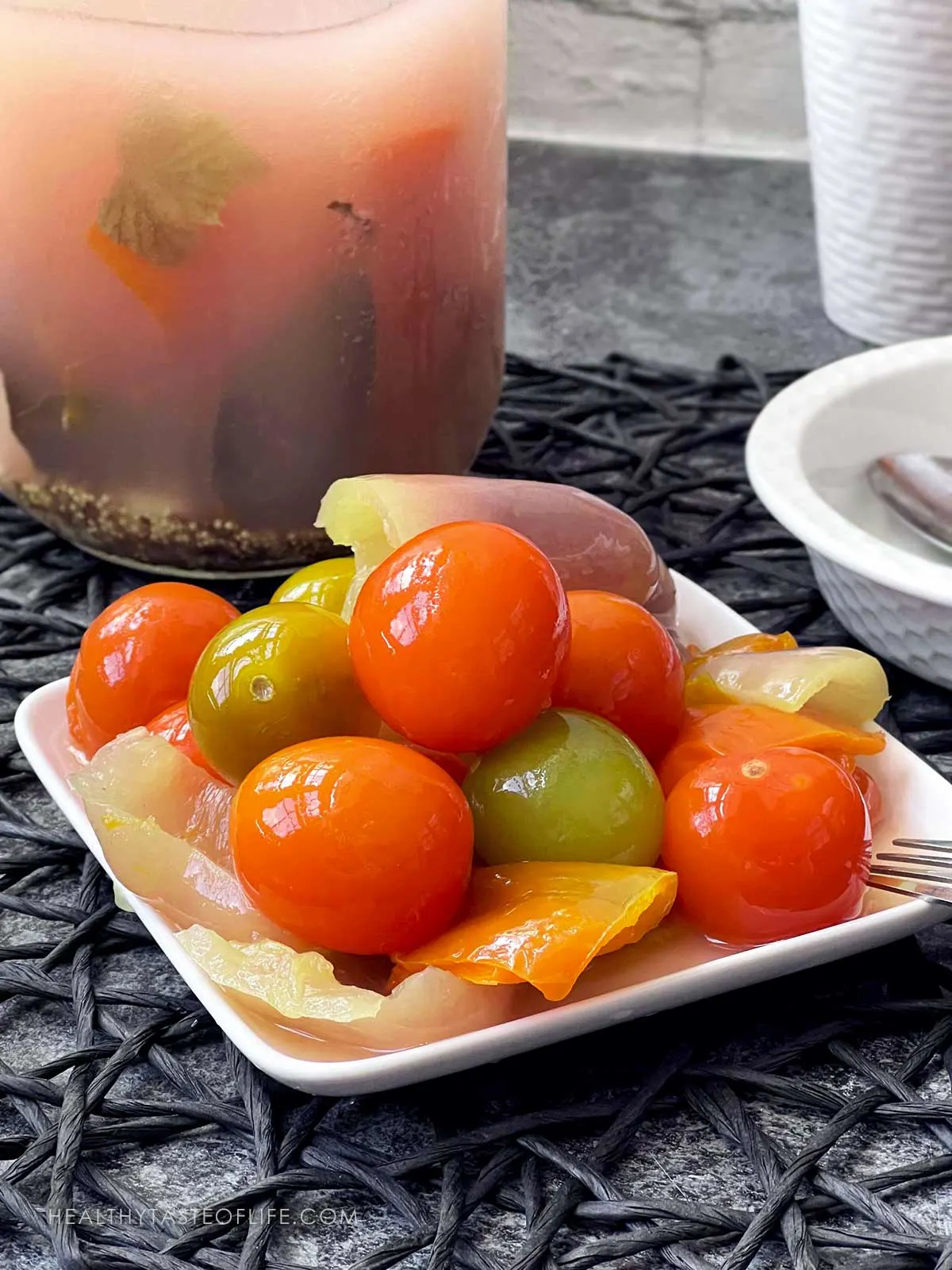
FAQs For Fermented Peppers and Tomatoes
Typically, it takes 5-7 days at room temperature. You can adjust the fermentation time based on your preferred level of tanginess.
When stored in the refrigerator, fermented tomatoes and peppers can last several months, retaining their flavor and nutritional benefits.
You can use either hot or sweet peppers, or a mix of both, depending on your taste preference. Hot peppers will add a spicy kick, while sweet peppers offer a milder flavor.
It’s optional. Removing seeds can reduce the heat in hot peppers, while leaving them in can add more spice to the ferment.
After fermentation, store them in the refrigerator to slow down the fermentation process and preserve the flavor.
Yes, cloudiness is a normal part of the fermentation process and indicates healthy bacterial activity.
Over-fermentation, high temperatures, or too much salt can cause mushiness. To avoid this, monitor the fermentation process closely and adjust as needed.
Yes, but it’s recommended to slice or puncture them to allow the brine to penetrate and ensure even fermentation.
Heads up: some links are affiliated & I may receive a small commission from qualifying sales. For more info see my disclaimer policy.
More Fermented Recipes To Try
If you tried this recipe, please share your experience in the comments below!
Your feed back is really important for me and readers!
I don’t forget to subscribe to the e-mail list for new posts and recipes!
Printable Recipe
Fermented Peppers And Tomatoes (How-to Guide)
Ingredients
- 2-3 peppers - regular, medium
- 1.5 lb tomatoes - cherry tomatoes or cocktail tomatoes (golf ball size)
- 6-10 cloves garlic - I tend to add more
- 3 leaves grape, oak, cherry, currant or bay leaves - (choose 1 or 2 types)
Brine
- 4.2 cups filtered water - ~ 1 liter (1000 ml)
- 1.8 tbsp Celtic sea salt - 30 grams
Optional Spices (But Recommended)
- 1 tsp whole black peppercorns
- 1 tsp whole mustard seeds
- 1 tsp whole coriander seeds
- 1 tsp celery seeds
Instructions
- Wash the tomatoes and peppers gently but thoroughly.
- If you have larger tomatoes, pierce each tomato with a clean skewer or a toothpick. This helps the brine penetrate better.
Prepare the Brine
- Mix sea salt with water until dissolved. The salt-to-water ratio in a brine affects taste and fermentation speed. I'll be using a 3% brine solution (1.8 tablespoons of sea salt in 4.2 cups of water which is ~1000 ml).
Arrange in The Jar
- Place the tomatoes and cut peppers (halved or quartered) in a sterilized jar (along with the spices or herbs if using, alternating in layers);
- Pour the brine, ensuring everyhting is submerged under.
- Use a fermentation weight to keep the everything submerged in the brine. Cover the jar with a fermentation lid or cheesecloth to prevent any falling dust, dirt or insects. Don't seal, the air is needed for fermentation.
- Tip: Placing a glass bowl filled with water on top can serve as weight and keep everything submerged under the brine constantly.
Ferment
- Store in a dark, cool place for 3-5 days, it depends on the temperature. A higher room teperature will speed up the fermentation process.
- Check daily to ensure the peppers and tomatoes remain submerged and to release gas buildup. Give the jar a shake or two.
- Once they reach your desired level of fermentation, transfer to the refrigerator to halt the process.
What You Need
Nutrition
The information shown is an estimate provided by an online nutrition calculator.

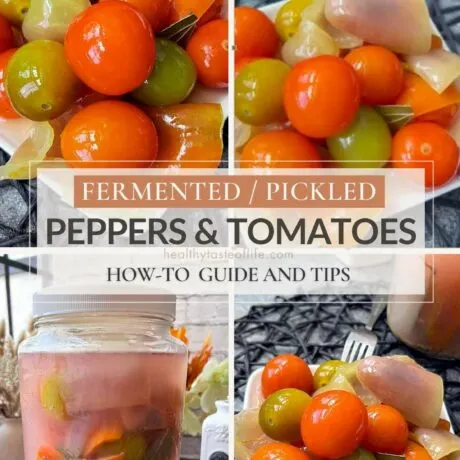
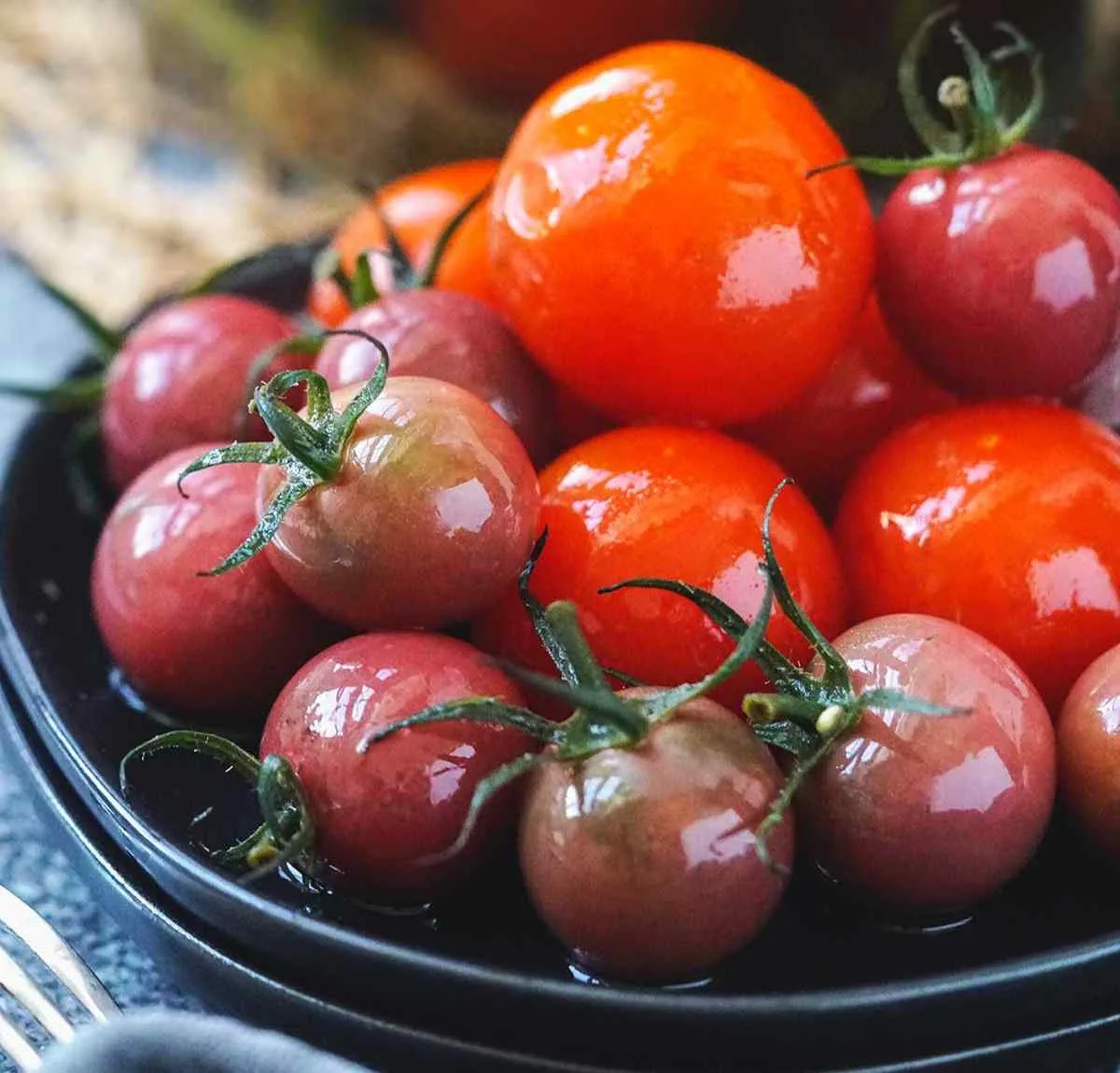
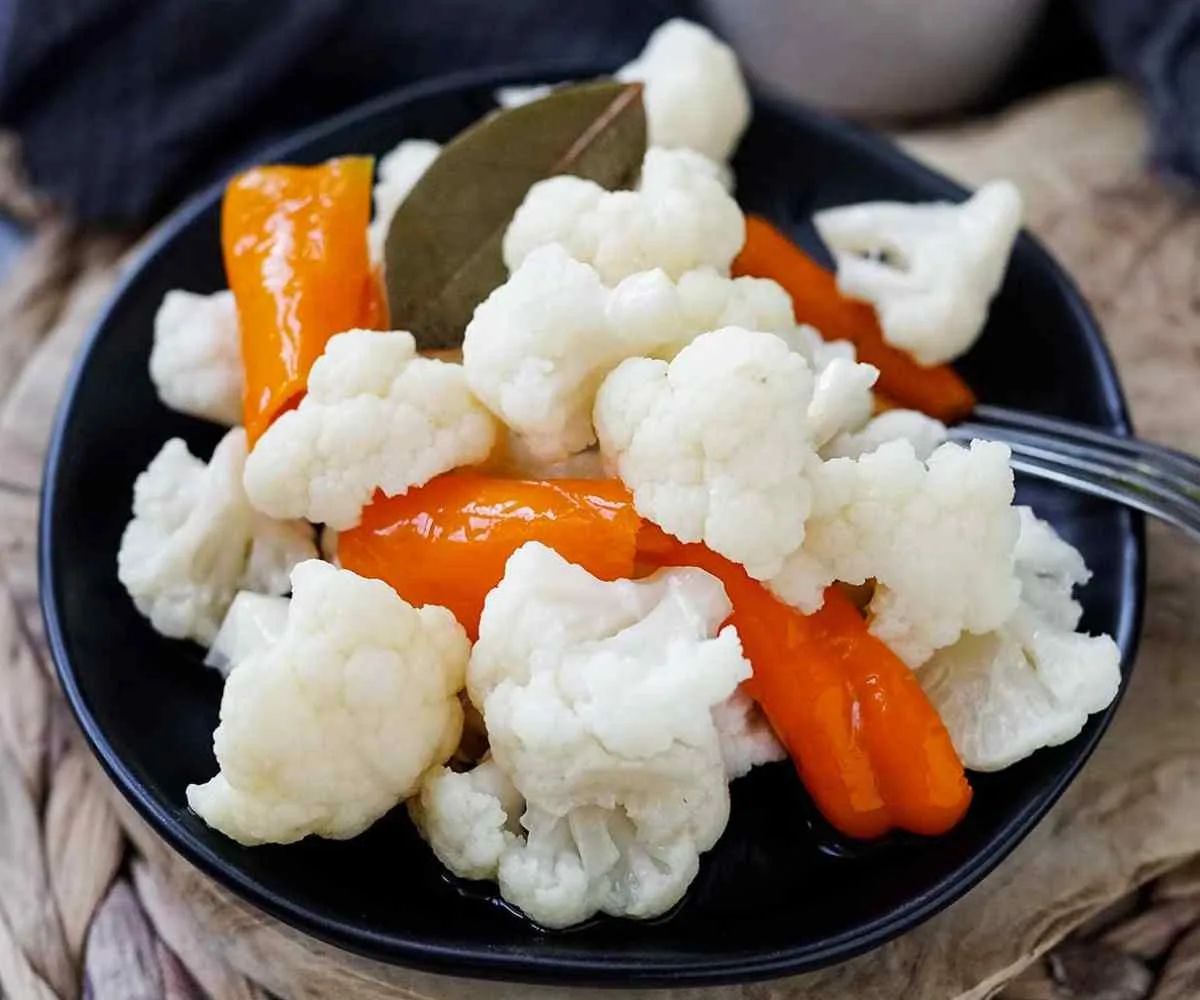

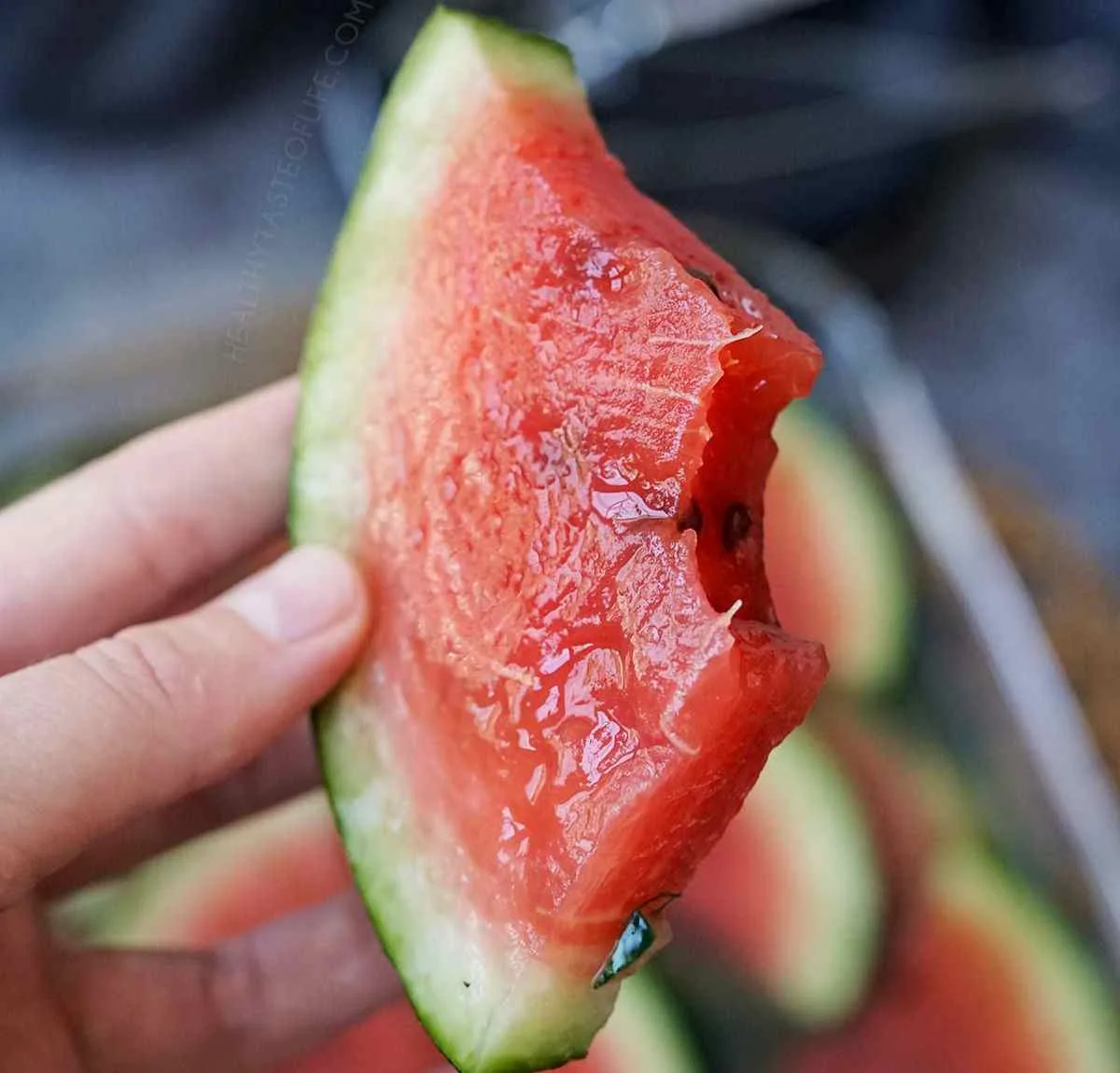

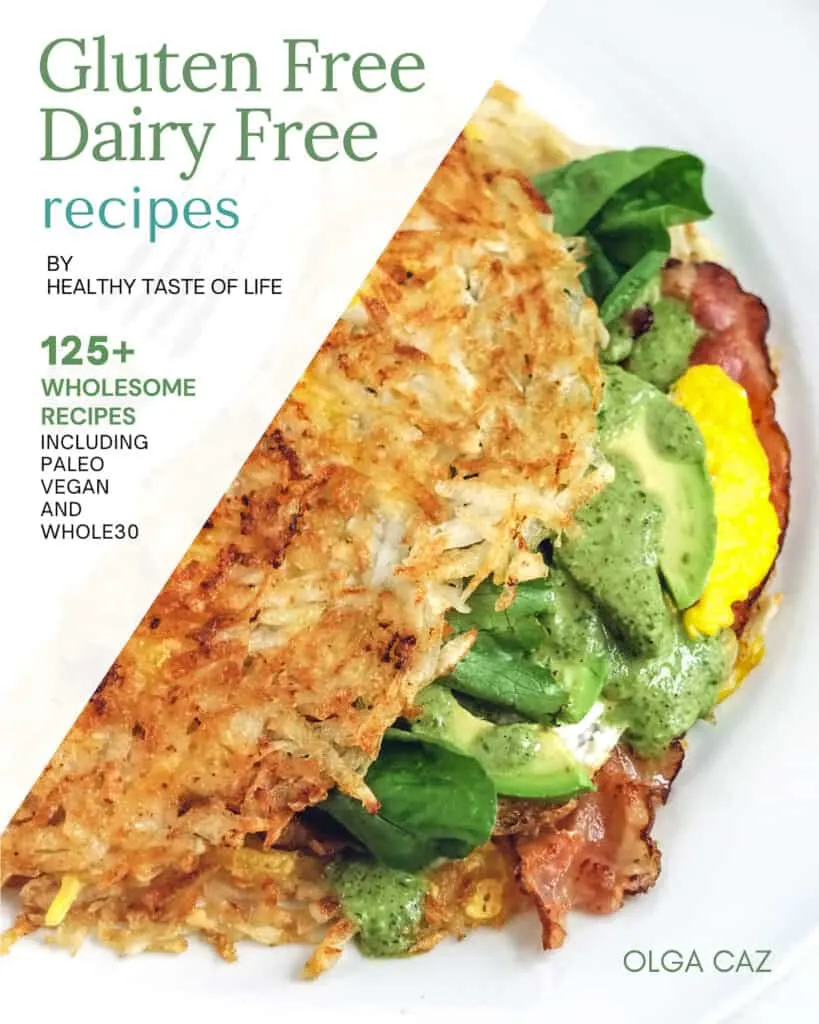
Mihaela
Sunday 29th of September 2024
Love all your recipes for fermenting veggies. Tried this one and it turned out delicious.